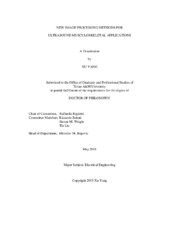| dc.description.abstract | In the past few years, ultrasound (US) imaging modalities have received increasing interest as diagnostic tools for orthopedic applications. The goal for many of these novel ultrasonic methods is to be able to create three-dimensional (3D) bone visualization non-invasively, safely and with high accuracy and spatial resolution. Availability of accurate bone segmentation and 3D reconstruction methods would help correctly interpreting complex bone morphology as well as facilitate quantitative analysis. However, in vivo ultrasound images of bones may have poor quality due to uncontrollable motion, high ultrasonic attenuation and the presence of imaging artifacts, which can affect the quality of the bone segmentation and reconstruction results.
In this study, we investigate the use of novel ultrasonic processing methods that can significantly improve bone visualization, segmentation and 3D reconstruction in ultrasound volumetric data acquired in applications in vivo. Specifically, in this study, we investigate the use of new elastography-based, Doppler-based and statistical shape model-based methods that can be applied to ultrasound bone imaging applications with the overall major goal of obtaining fast yet accurate 3D bone reconstructions. This study is composed to three projects, which all have the potential to significantly contribute to this major goal.
The first project deals with the fast and accurate implementation of correlation-based elastography and poroelastography techniques for real-time assessment of the mechanical properties of musculoskeletal tissues. The rationale behind this project is that,
iii
in the future, elastography-based features can be used to reduce false positives in ultrasonic bone segmentation methods based on the differences between the mechanical properties of soft tissues and the mechanical properties of hard tissues. In this study, a hybrid computation model is designed, implemented and tested to achieve real time performance without compromise in elastographic image quality .
In the second project, a Power Doppler-based signal enhancement method is designed and tested with the intent of increasing the contrast between soft tissue and bone while suppressing the contrast between soft tissue and connective tissue, which is often a cause of false positives in ultrasonic bone segmentation problems. Both in-vitro and in-vivo experiments are performed to statistically analyze the performance of this method.
In the third project, a statistical shape model based bone surface segmentation method is proposed and investigated. This method uses statistical models to determine if a curve detected in a segmented ultrasound image belongs to a bone surface or not. Both in-vitro and in-vivo experiments are performed to statistically analyze the performance of this method.
I conclude this Dissertation with a discussion on possible future work in the field of ultrasound bone imaging and assessment. | en |


